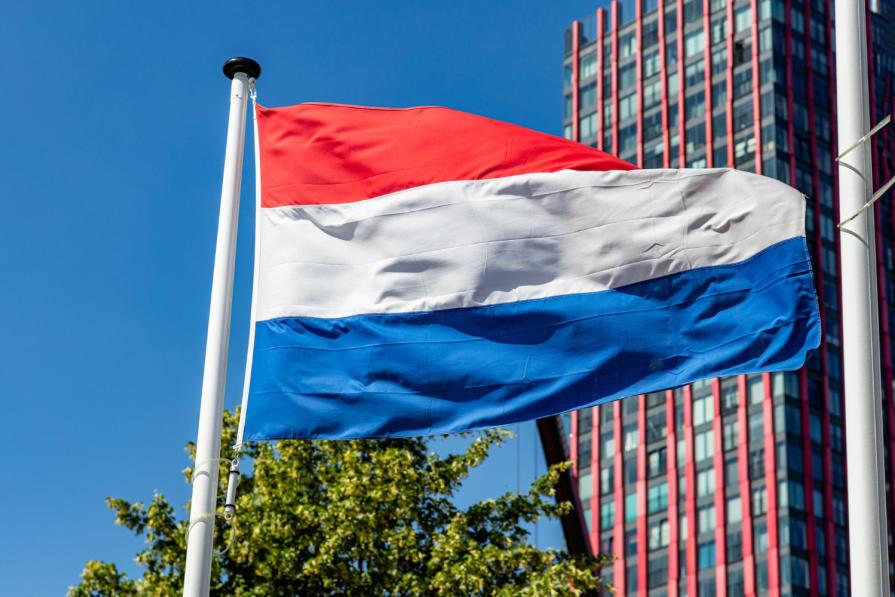The Dutch flag - a classic tricolor of horizontally lined red, white and blue stripes - is nothing more than a variant of the Orange flag of the prince, common at the end of the XVI century and replaced at the beginning of the XVII state - naval and military symbol of the States-General of the Dutch Republic.
Surprisingly, the official status of the flag was fixed only in the winter of 1937, when, against the background of a pan-European crisis, right-wing radicals began to use Orangeist symbols in the hope of enlisting the support of the dynasty. The monarch responded quickly and uncompromisingly, by personal decree establishing a red-white-blue banner as the national banner for the whole Kingdom.

Symbolism
Of course, a country in the heart of Europe cannot but have a rich heraldic tradition. All the stripes on the flag of the Netherlands carry a colossal semantic meaning:
- red is characterized by courage, fortitude and valor
- white – peacefulness and honesty
- blue – loyalty to ideals, perseverance, the desire for justice.
History
The roots of the banner go back to the distant past - in the XV century, when most of the local lands were under the rule of the dukes of Burgundy. At that time, a scarlet four-pointed cross with spikes on a white background fluttered over the country. The same was used by the Spanish Habsburgs, supplementing it with their yellow and red (somewhat different from dutch).
In 1568, part of the Dutch provinces rebelled against the Spanish king Philip. At the head of the struggle stood Prince William of Orange. The etymology of the surname is not related to fruit or color, and the use of flowers dates back to the prince's livery, which was first seen during the Leiden Siege of 1574: then the prince's officers wore rosettes of appropriate colors to distinguish themselves from the Spanish soldiers and German mercenaries who flooded the country. The first color image dates back to 1575, and the official mention dates only 1587: then the Admiralty of the Province of Zealand announced that the colors were chosen for the naval flag of the provincial fleet.
It is these colors that are considered the senior flag of the republic. In 1972, the four-hundredth anniversary of its introduction was celebrated with fanfare: in addition to the celebration, a stamp was printed. True, the anniversary was timed to coincide with the pirate seizure: it was in this year that the Gezas managed to seize the first Spanish ships off the coast of the rebellious provinces in the name of William.
Subsequently, supporters of democracy and the republic insisted on replacing orange with red. But even after that, the Orange symbol formed the basis of the flags of New York, the Orange Free State, a dozen other Boer republics in South Africa and the city of Albany - the former Dutch possessions.

Statenvlag – National flag
Red first changed the colors of oranges in 1596, but most actively it began to be used since 1630. This is associated with chemistry: the dye used consisted of two pigments, yellow and red. The first was less durable and quickly faded in the sun, turning the stripe from orange to red after a while.
Until 1664, the tricolor red-white-blue bore the name "Dutch" in honor of one of the rebellious provinces. This caused jealousy of other lands of the new state, in December 1664, the Government of Zealand appealed to the States with a demand to understand.

So there was a name "Stadtflag" - state. On land, it came into use immediately, and in the navy between 1588 and 1630 preferred the flag of the prince, and then - the state; from 1640 to 1662 both were used, both on land and at sea.
There is a strong belief that the tricolor influenced the original design of the Russian flag and banner of revolutionary France: in the Kingdom of Bourbon, the Netherlands enjoyed a strong reputation as a bastion of freedom. Plus, they were an oligopolistic, but a republic.
The New Revolution
The last decade of the XVIII century was marked by a new revolution, which received the name batavskaya; the prince's flag was banned, and the sister republic based on holland officially approved the red-white-blue state – only because it repeated the colors of the revolutionary banner of France.
In 1796, the red stripe was decorated with the image of a girl in a national dress, at whose feet a lion lay. In her right hand she clutched a spear topped with a Phrygian cap, and in her left she clutched a bundle of fascia and a shield.
The life of this symbol was short-lived, as was the republic itself: Louis, Napoleon's brother, built his policy in line with national interests, rightly believing that revolutions come and go, and monarchy for a long time. The virgin was removed, the tricolor was returned to its former place.
Unfortunately, Louis's independent policy did not bear the fruits he had hoped for: the conflict with his brother provoked annexation, and up to the Congress of Vienna, the Netherlands became an integral part of Napoleon's empire.

Modern flag
In 1813, independence was restored, the Orange returned to the throne, and the state tricolor for some time was pushed orange - as a manifestation of loyal feelings.
This did not last long, though.
A new surge of interest in the prince's flowers coincided with the growth of the nationalist movement before World War II. To avoid insinuation, the monarchy determined the colors by royal decree of 19 February 1937 signed by Wilhelmina.

Flags owed their appearance to Holland
Just as Holland was the sister republic of France, the Dutch flag became the ancestor of a whole line of flags, under some of them a great History was made. Let's mention just a few of them:
New Holland (Brazil)
Also known as Dutch Brazilian, it was used in the West Indies between 1630 and 1654 and was the three stripes of the color of the republic. On the central one there is a monogram, and on the upper one there is a crown of yellow color.
Netherlands East Indies
For most of the history of this colony, the flag of the East India Company has been used. After its bankruptcy in 1800, the property was transferred to the government of the newly formed Batavian Republic, and the territory became a crown colony and experienced a period of intense growth to eventually capture the entire archipelago (with the exception of a few British enclaves).
There is a version that the basis of the Indonesian flag is Dutch: they say, the local leaders of the national liberation movement tore up the flag, separating the lower third from it.
In addition, the flag of this country formed the basis of almost all the flags of the short-lived Boer republics of South Africa and Namibia: from the internationally recognized Transvaal and Orange Free State to tiny self-proclaimed entities like the Transkey. By the way, the colors were used for the second time, when the apartheid regime tried to form Bantustans on the territory of the country - unilaterally recognized states for blacks.












